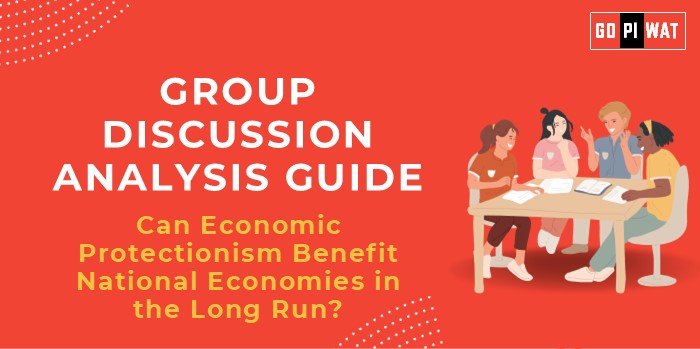📋 Group Discussion (GD) Analysis Guide: Can Economic Protectionism Benefit National Economies in the Long Run?
🌐 Introduction to Economic Protectionism
Economic protectionism is gaining renewed prominence as nations navigate trade wars, geopolitical tensions, and post-pandemic recovery efforts. While proponents argue it shields domestic industries, critics warn of inefficiencies and trade distortions. Protectionism, characterized by tariffs, subsidies, and import restrictions, has shaped global trade policies for decades. Recent measures, such as the U.S.-China trade war and India’s Atmanirbhar Bharat initiative, reveal diverse approaches to balancing self-reliance and globalization.
📊 Quick Facts and Key Statistics
• 🌍 Global Tariff Rates: The average global tariff rate is approximately 2.5%, reflecting a relatively open trade environment.
• 🇺🇸 U.S.-China Trade War: U.S. tariffs on $370 billion of Chinese goods resulted in a 16% reduction in imports, with U.S. companies bearing the costs.
• 🇮🇳 India’s Atmanirbhar Bharat: The PLI scheme allocates ₹1.97 lakh crore (~$26 billion) to boost domestic manufacturing and exports across 14 sectors.
• 🇪🇺 EU Semiconductor Strategy: The European Chips Act mobilizes €43 billion in investments to strengthen the EU’s semiconductor supply chain.
• 📉 Export Restrictions: A surge in global export control measures since 2020 signals a pivot toward protectionist policies.
• 🇺🇸 U.S.-China Trade War: U.S. tariffs on $370 billion of Chinese goods resulted in a 16% reduction in imports, with U.S. companies bearing the costs.
• 🇮🇳 India’s Atmanirbhar Bharat: The PLI scheme allocates ₹1.97 lakh crore (~$26 billion) to boost domestic manufacturing and exports across 14 sectors.
• 🇪🇺 EU Semiconductor Strategy: The European Chips Act mobilizes €43 billion in investments to strengthen the EU’s semiconductor supply chain.
• 📉 Export Restrictions: A surge in global export control measures since 2020 signals a pivot toward protectionist policies.
👥 Stakeholders and Their Roles
- Governments: Formulate protectionist policies, offer subsidies, and implement tariffs to promote domestic industries.
- Businesses: Adapt supply chains and strategies to align with changing trade regulations.
- Workers: Potential beneficiaries of increased job opportunities in protected industries but risk higher living costs.
- Global Trade Bodies: WTO and others monitor and mediate trade disputes arising from protectionist policies.
🏆 Achievements and Challenges
- Achievements:
- 📈 Industry Growth: India’s PLI scheme catalyzed investments in electronics and renewable energy.
- 🏭 Supply Chain Resilience: The EU’s Chips Act mitigates semiconductor shortages by localizing production.
- 🤝 Strategic Autonomy: Reduced dependency on imports in critical sectors, such as defense and healthcare.
- Challenges:
- 💸 Higher Consumer Costs: U.S. companies incurred costs from tariffs during the U.S.-China trade war, indirectly burdening consumers.
- ⚔️ Global Trade Tensions: Export restrictions and retaliatory tariffs exacerbate geopolitical conflicts.
- 📉 Innovation Stagnation: Over-reliance on domestic markets can deter competition and technological advancement.
💡 Effective Discussion Approaches
- Opening Approaches:
- 📊 Statistical Start: “With global tariffs averaging 2.5%, protectionist policies stand out as strategic exceptions in trade ecosystems.”
- 📖 Case Study: “The U.S.-China trade war demonstrated both the potential benefits and pitfalls of protectionism, reducing imports by 16% while increasing costs for U.S. businesses.”
- Counter-Argument Handling:
- ✔️ Highlight global dependencies and the balance between self-reliance and free trade.
- 🌍 Address inefficiencies in overly protected industries with comparative examples like Argentina.
🔍 Strategic Analysis of Strengths & Weaknesses
- 🏅 Strengths:
- 🛡️ Protection for vulnerable industries.
- 💼 Employment growth in targeted sectors.
- ⚙️ Strategic self-reliance in critical areas (e.g., semiconductors).
- ⚠️ Weaknesses:
- 💸 Increased consumer prices.
- 📉 Reduced competitiveness and innovation.
- ⚔️ Risk of retaliatory trade measures.
- 🌱 Opportunities: Leverage emerging technologies like AI and semiconductors for industrial growth, enhance regional trade partnerships to mitigate risks.
- ⚡ Threats: Trade wars disrupting global supply chains, regulatory backlash from international trade bodies.
📄 Structured Arguments for Discussion
- Supporting Stance: “Protectionism nurtures nascent industries, as seen with India’s PLI scheme boosting manufacturing.”
- Opposing Stance: “High tariffs harm consumers and distort markets, as evidenced in the U.S.-China trade war.”
- Balanced Perspective: “While protectionism ensures economic security, excessive reliance can stifle innovation and trade relations.”
🎓 Connecting with B-School Applications
- Real-World Applications: Analyze protectionism’s impact on supply chain optimization or global strategy development in case studies.
- Sample Interview Questions:
- 💡 “How does protectionism align with globalization trends?”
- 💡 “Discuss the long-term viability of protectionist policies in sectors like semiconductors.”
- Insights for Students:
- 📖 Explore the intersection of trade policies and corporate strategy.
- 🌍 Study global protectionist trends for internship projects or research papers.


